The Effects of Natural Window Views in Classrooms on College Students’ Mood and Learning Efficiency
Abstract
1. Introduction
2. Materials and Methods
2.1. Participants
2.2. Experimental Environment
2.3. Experimental Process
2.4. Physiological Measurement
2.5. Standardized Focused Attention Test (Word Association Task)
2.6. Psychological Measurement
2.7. Data Analysis
3. Results
3.1. Physiological Reactions
3.1.1. Analysis of EEG Theta, Alpha, and Beta Waves
3.1.2. Analysis of Attention Level Results
3.1.3. Analysis of HRV Index Results
3.2. Psychological Reactions
3.2.1. Reliability of Questionnaire Scales
3.2.2. Analysis of SD Scale Results
3.2.3. Analysis of POMS Scale Results
3.3. Analysis of Results of Standardized Focused Attention Test (Word Association Task)
4. Discussion
5. Conclusions
Author Contributions
Funding
Data Availability Statement
Conflicts of Interest
References
- Yang, H.; Wen, J.; Lu, Y.; Peng, Q. A Quasi-Experimental Study on the Impact of Park Accessibility on the Mental Health of Undergraduate Students. Urban For. Urban Green. 2023, 86, 127979. [Google Scholar] [CrossRef]
- Ferrari, A.J.; Charlson, F.J.; Norman, R.E.; Patten, S.B.; Freedman, G.; Murray, C.J.L.; Vos, T.; Whiteford, H.A. Burden of Depressive Disorders by Country, Sex, Age, and Year: Findings from the Global Burden of Disease Study 2010. PLoS Med. 2013, 10, e1001547. [Google Scholar] [CrossRef] [PubMed]
- Hartig, T.; Mitchell, R.; De Vries, S.; Frumkin, H. Nature and Health. Annu. Rev. Public Health 2014, 35, 207–228. [Google Scholar] [CrossRef] [PubMed]
- Dzhambov, A.M.; Dimitrova, D.D. Elderly Visitors of an Urban Park, Health Anxiety and Individual Awareness of Nature Experiences. Urban For. Urban Green. 2014, 13, 806–813. [Google Scholar] [CrossRef]
- Putra, I.G.N.E.; Astell-Burt, T.; Cliff, D.P.; Vella, S.A.; Feng, X. Do Physical Activity, Social Interaction, and Mental Health Mediate the Association between Green Space Quality and Child Prosocial Behaviour? Urban For. Urban Green. 2021, 64, 127264. [Google Scholar] [CrossRef]
- Helbich, M.; Yao, Y.; Liu, Y.; Zhang, J.; Liu, P.; Wang, R. Using Deep Learning to Examine Street View Green and Blue Spaces and Their Associations with Geriatric Depression in Beijing, China. Environ. Int. 2019, 126, 107–117. [Google Scholar] [CrossRef] [PubMed]
- Ibrahim, A.K.; Kelly, S.J.; Adams, C.E.; Glazebrook, C. A Systematic Review of Studies of Depression Prevalence in University Students. J. Psychiatr. Res. 2013, 47, 391–400. [Google Scholar] [CrossRef] [PubMed]
- Auerbach, R.P.; Mortier, P.; Bruffaerts, R.; Alonso, J.; Benjet, C.; Cuijpers, P.; Demyttenaere, K.; Ebert, D.D.; Green, J.G.; Hasking, P.; et al. WHO World Mental Health Surveys International College Student Project: Prevalence and Distribution of Mental Disorders. J. Abnorm. Psychol. 2018, 127, 623–638. [Google Scholar] [CrossRef] [PubMed]
- Ramachandiran, M.; Dhanapal, S. Academic Stress Among University Students: A Quantitative Study of Generation Y and Z’s Perception. Pertanika J. Soc. Sci. Humanit. 2018, 26, 2115–2128. [Google Scholar]
- Pedersen, D.E.; Jodin, V. Stressors Associated with the School Spillover of College Undergraduates. Soc. Soc. Sci. J. 2016, 53, 40–48. [Google Scholar] [CrossRef]
- Hetolang, L.T.; Amone-P’Olak, K. The Associations between Stressful Life Events and Depression among Students in a University in Botswana. S. J. Psychol. 2018, 48, 255–267. [Google Scholar] [CrossRef]
- Adams, D.R.; Meyers, S.A.; Beidas, R.S. The Relationship between Financial Strain, Perceived Stress, Psychological Symptoms, and Academic and Social Integration in Undergraduate Students. J. Am. Coll. Health 2016, 64, 362–370. [Google Scholar] [CrossRef] [PubMed]
- Pascoe, M.C.; Hetrick, S.E.; Parker, A.G. The Impact of Stress on Students in Secondary School and Higher Education. Int. J. Adolesc. Youth 2020, 25, 104–112. [Google Scholar] [CrossRef]
- Zhang, J.; Jin, J.; Liang, Y. The Impact of Green Space on University Students’ Mental Health: The Mediating Roles of Solitude Competence and Perceptual Restoration. Sustainability 2024, 16, 707. [Google Scholar] [CrossRef]
- Hipp, J.A.; Gulwadi, G.B.; Alves, S.; Sequeira, S. The Relationship Between Perceived Greenness and Perceived Restorativeness of University Campuses and Student-Reported Quality of Life. Environ. Behav. 2016, 48, 1292–1308. [Google Scholar] [CrossRef]
- Kaplan, S. The Restorative Benefits of Nature: Toward an Integrative Framework. J. Environ. Psychol. 1995, 15, 169–182. [Google Scholar] [CrossRef]
- Jennings, V.; Bamkole, O. The Relationship between Social Cohesion and Urban Green Space: An Avenue for Health Promotion. Int. J. Environ. Res. Public Health 2019, 16, 452. [Google Scholar] [CrossRef] [PubMed]
- Lee, A.; Jordan, H.; Horsley, J. Value of Urban Green Spaces in Promoting Healthy Living and Wellbeing: Prospects for Planning. Risk Manag. Healthc. Policy 2015, 131, 131–137. [Google Scholar] [CrossRef] [PubMed]
- Shao, Y.; Elsadek, M.; Liu, B. Horticultural Activity: Its Contribution to Stress Recovery and Wellbeing for Children. Int. J. Environ. Res. Public Health 2020, 17, 1229. [Google Scholar] [CrossRef]
- Elsadek, M.; Liu, B.; Lian, Z.; Xie, J. The Influence of Urban Roadside Trees and Their Physical Environment on Stress Relief Measures: A Field Experiment in Shanghai. Urban For. Urban Green. 2019, 42, 51–60. [Google Scholar] [CrossRef]
- Swierad, E.M.; Huang, T.T.K. An Exploration of Psychosocial Pathways of Parks’ Effects on Health: A Qualitative Study. Int. J. Environ. Res. Public Health 2018, 15, 1693. [Google Scholar] [CrossRef] [PubMed]
- Seitz, C.M.; Reese, R.F.; Strack, R.W.; Frantz, S.; West, B. Identifying and Improving Green Spaces on a College Campus: A Photovoice Study. Ecopsychology 2014, 6, 98–108. [Google Scholar] [CrossRef]
- Ulrich, R.S.; Simons, R.F.; Losito, B.D.; Fiorito, E.; Miles, M.A.; Zelson, M. Stress Recovery during Exposure to Natural and Urban Environments. J. Environ. Psychol. 1991, 11, 201–230. [Google Scholar] [CrossRef]
- Stone, N.J.; Irvine, J.M. Direct or Indirect Window Access, Task Type, and Performance. J. Environ. Psychol. 1994, 14, 57–63. [Google Scholar] [CrossRef]
- Ulrich, R.S. View through a Window May Influence Recovery from Surgery. Sci. New Ser. 1984, 224, 420–421. [Google Scholar] [CrossRef]
- Gilchrist, K.; Brown, C.; Montarzino, A. Workplace Settings and Wellbeing: Greenspace Use and Views Contribute to Employee Wellbeing at Peri-Urban Business Sites. Landsc. Urban Plan. 2015, 138, 32–40. [Google Scholar] [CrossRef]
- Tennessen, C.M.; Cimprich, B. Views to Nature: Effects on Attention. J. Environ. Psychol. 1995, 15, 77–85. [Google Scholar] [CrossRef]
- Lindemann-Matthies, P.; Benkowitz, D.; Hellinger, F. Associations between the Naturalness of Window and Interior Classroom Views, Subjective Well-Being of Primary School Children and Their Performance in an Attention and Concentration Test. Landsc. Urban Plan. 2021, 214, 104146. [Google Scholar] [CrossRef]
- Li, D.; Sullivan, W.C. Impact of Views to School Landscapes on Recovery from Stress and Mental Fatigue. Landsc. Urban Plan. 2016, 148, 149–158. [Google Scholar] [CrossRef]
- Matsuoka, R.H. Student Performance and High School Landscapes: Examining the Links. Landsc. Urban Plan. 2010, 97, 273–282. [Google Scholar] [CrossRef]
- Yang, Z.; Becerik-Gerber, B.; Mino, L. A Study on Student Perceptions of Higher Education Classrooms: Impact of Classroom Attributes on Student Satisfaction and Performance. Build. Environ. 2013, 70, 171–188. [Google Scholar] [CrossRef]
- Fisher, K.R. The Impact of School Infrastructure on Student Outcomes and Behaviour; Australian Department of Education, Science and Training: Canberra, Australia, 2007. [Google Scholar]
- Annesi-Maesano, I.; Baiz, N.; Banerjee, S.; Rudnai, P.; Rive, S. The Sinphonie Group Indoor Air Quality and Sources in Schools and Related Health Effects. J. Toxicol. Environ. Health Part B 2013, 16, 491–550. [Google Scholar] [CrossRef] [PubMed]
- Haverinen-Shaughnessy, U.; Shaughnessy, R.J.; Cole, E.C.; Toyinbo, O.; Moschandreas, D.J. An Assessment of Indoor Environmental Quality in Schools and Its Association with Health and Performance. Build. Environ. 2015, 93, 35–40. [Google Scholar] [CrossRef]
- Turunen, M.; Toyinbo, O.; Putus, T.; Nevalainen, A.; Shaughnessy, R.; Haverinen-Shaughnessy, U. Indoor Environmental Quality in School Buildings, and the Health and Wellbeing of Students. Int. J. Hyg. Environ. Health 2014, 217, 733–739. [Google Scholar] [CrossRef] [PubMed]
- Simons, E.; Hwang, S.-A.; Fitzgerald, E.F.; Kielb, C.; Lin, S. The Impact of School Building Conditions on Student Absenteeism in Upstate New York. Am. J. Public Health 2010, 100, 1679–1686. [Google Scholar] [CrossRef] [PubMed]
- Sleegers, P.; Moolenaar, N.; Galetzka, M.; Pruyn, A.; Sarroukh, B.; Van Der Zande, B. Lighting Affects Students’ Concentration Positively: Findings from Three Dutch Studies. Light. Res. Technol. 2013, 45, 159–175. [Google Scholar] [CrossRef]
- Downs, D.W.; Crum, M.A. Processing Demands during Auditory Learning under Degraded Listening Conditions. J. Speech Hear. Res. 1978, 21, 702–714. [Google Scholar] [CrossRef]
- Juan, Y.-K.; Chen, Y. The Influence of Indoor Environmental Factors on Learning: An Experiment Combining Physiological and Psychological Measurements. Build. Environ. 2022, 221, 109299. [Google Scholar] [CrossRef]
- Coley, D.A.; Greeves, R.; Saxby, B.K. The Effect of Low Ventilation Rates on the Cognitive Function of a Primary School Class. Int. J. Vent. 2007, 6, 107–112. [Google Scholar] [CrossRef]
- Wang, C.; Zhang, F.; Wang, J.; Doyle, J.K.; Hancock, P.A.; Mak, C.M.; Liu, S. How Indoor Environmental Quality Affects Occupants’ Cognitive Functions: A Systematic Review. Build. Environ. 2021, 193, 107647. [Google Scholar] [CrossRef]
- Kweon, B.-S.; Ellis, C.D.; Lee, J.; Jacobs, K. The Link between School Environments and Student Academic Performance. Urban For. Urban Green. 2017, 23, 35–43. [Google Scholar] [CrossRef]
- Chen, C. Impact of Nature Window View On High School Students Stress Recovery. Ph.D. Thesis, University of Illinois at Urbana-Champaign, Champaign, IL, USA, 2015. [Google Scholar]
- Amanvermez, Y.; Karyotaki, E.; Cuijpers, P.; Ciharova, M.; Bruffaerts, R.; Kessler, R.C.; Klein, A.M.; Wiers, R.W.; De Wit, L.M. Sources of Stress among Domestic and International Students: A Cross-Sectional Study of University Students in Amsterdam, The Netherlands. Anxiety Stress Coping 2023, 1–18. [Google Scholar] [CrossRef]
- Elsadek, M.; Liu, B.; Xie, J. Window View and Relaxation: Viewing Green Space from a High-Rise Estate Improves Urban Dwellers’ Wellbeing. Urban For. Urban Green. 2020, 55, 126846. [Google Scholar] [CrossRef]
- Benfield, J.A.; Rainbolt, G.N.; Bell, P.A.; Donovan, G.H. Classrooms with Nature Views: Evidence of Differing Student Perceptions and Behaviors. Environ. Behav. 2015, 47, 140–157. [Google Scholar] [CrossRef]
- Filges, T.; Sonne-Schmidt, C.S.; Nielsen, B.C.V. Small Class Sizes for Improving Student Achievement in Primary and Secondary Schools: A Systematic Review. Campbell Syst. Rev. 2018, 14, 1–107. [Google Scholar] [CrossRef] [PubMed]
- Falch, T.; Sandsør, A.M.J.; Strøm, B. Do Smaller Classes Always Improve Students’ Long-run Outcomes? Oxf. Bull. Econ. Stat. 2017, 79, 654–688. [Google Scholar] [CrossRef]
- Phillips, D.E. The Elective System in American Education. Pedagog. Semin. 1901, 8, 206–230. [Google Scholar] [CrossRef]
- Parameswaran, A.; Venetis, P.; Garcia-Molina, H. Recommendation Systems with Complex Constraints: A Course Recommendation Perspective. ACM Trans. Inf. Syst. 2011, 29, 1–33. [Google Scholar] [CrossRef]
- Holden, L.J.; Mercer, T. Nature in the Learning Environment: Exploring the Relationship between Nature, Memory, and Mood. Ecopsychology 2014, 6, 234–240. [Google Scholar] [CrossRef]
- Studente, S.; Seppala, N.; Sadowska, N. Facilitating Creative Thinking in the Classroom: Investigating the Effects of Plants and the Colour Green on Visual and Verbal Creativity. Think. Ski. Creat. 2016, 19, 1–8. [Google Scholar] [CrossRef]
- Lieberman, M.D. Social Cognitive Neuroscience: A Review of Core Processes. Annu. Rev. Psychol. 2007, 58, 259–289. [Google Scholar] [CrossRef] [PubMed]
- Falk, E.B.; Berkman, E.T.; Mann, T.; Harrison, B.; Lieberman, M.D. Predicting Persuasion-Induced Behavior Change from the Brain. J. Neurosci. 2010, 30, 8421–8424. [Google Scholar] [CrossRef]
- Fortunato, V.C.R.; Giraldi, J.D.M.E.; De Oliveira, J.H.C. A Review of Studies on Neuromarketing: Practical Results, Techniques, Contributions and Limitations. JMR 2014, 6, 201. [Google Scholar] [CrossRef]
- Piwowarski, M.; Gadomska-Lila, K.; Nermend, K. Cognitive Neuroscience Methods in Enhancing Health Literacy. Int. J. Environ. Res. Public Health 2021, 18, 5331. [Google Scholar] [CrossRef] [PubMed]
- Schafer, E.W.P. Brain Responses While Viewing Television Reflect Program Interest. Int. J. Neurosci. 1978, 8, 71–77. [Google Scholar] [CrossRef]
- Olszewska-Guizzo, A.; Escoffier, N.; Chan, J.; Puay Yok, T. Window View and the Brain: Effects of Floor Level and Green Cover on the Alpha and Beta Rhythms in a Passive Exposure EEG Experiment. Int. J. Environ. Res. Public Health 2018, 15, 2358. [Google Scholar] [CrossRef] [PubMed]
- Beyer, K.M.M.; Kaltenbach, A.; Szabo, A.; Bogar, S.; Nieto, F.J.; Malecki, K.M. Exposure to Neighborhood Green Space and Mental Health: Evidence from the Survey of the Health of Wisconsin. Int. J. Environ. Res. Public. Health 2014, 11, 3453–3472. [Google Scholar] [CrossRef] [PubMed]
- Elsadek, M.; Liu, B. Effects of Viewing Flowering Plants on Employees’ Wellbeing in an Office-like Environment. Indoor Built Environ. 2021, 30, 1429–1440. [Google Scholar] [CrossRef]
- Deng, L.; Li, X.; Luo, H.; Fu, E.-K.; Ma, J.; Sun, L.-X.; Huang, Z.; Cai, S.-Z.; Jia, Y. Empirical Study of Landscape Types, Landscape Elements and Landscape Components of the Urban Park Promoting Physiological and Psychological Restoration. Urban For. Urban Green. 2020, 48, 126488. [Google Scholar] [CrossRef]
- Jang, H.S.; Kim, J.; Kim, K.S.; Pak, C.H. Human Brain Activity and Emotional Responses to Plant Color Stimuli. Color Res. Appl. 2014, 39, 307–316. [Google Scholar] [CrossRef]
- Ding, N.; Zhong, Y.; Li, J.; Xiao, Q.; Zhang, S.; Xia, H. Visual Preference of Plant Features in Different Living Environments Using Eye Tracking and EEG. PLoS ONE 2022, 17, e0279596. [Google Scholar] [CrossRef] [PubMed]
- Sezer, A.; Inel, Y.; Seçkin, A.Ç.; Uluçinar, U. The Relationship between Attention Levels and Class Participation of First-Year Students in Classroom Teaching Departments. Int. J. Instr. 2017, 10, 55–68. [Google Scholar] [CrossRef]
- Elsadek, M.; Liu, B.; Lian, Z. Green Façades: Their Contribution to Stress Recovery and Well-Being in High-Density Cities. Urban For. Urban Green. 2019, 46, 126446. [Google Scholar] [CrossRef]
- Shibata, S.; Suzuki, N. Effects of an Indoor Plant on Creative Task Performance and Mood. Scand. J. Psychol. 2004, 45, 373–381. [Google Scholar] [CrossRef] [PubMed]
- Shibata, S.; Suzuki, N. Effects of the foliage plant on task performance and mood. J. Environ. Psychol. 2002, 22, 265–272. [Google Scholar] [CrossRef]
- Williams, K.J.H.; Cary, J. Landscape Preferences, Ecological Quality, and Biodiversity Protection. Environ. Behav. 2002, 34, 257–274. [Google Scholar] [CrossRef]
- Schacter, D.L. EEG Theta Waves and Psychological Phenomena: A Review and Analysis. Biol. Psychol. 1977, 5, 47–82. [Google Scholar] [CrossRef] [PubMed]
- Lee, B.-G.; Lee, B.-L.; Chung, W.-Y. Mobile Healthcare for Automatic Driving Sleep-Onset Detection Using Wavelet-Based EEG and Respiration Signals. Sensors 2014, 14, 17915–17936. [Google Scholar] [CrossRef]
- Han, K.-T. Influence of Limitedly Visible Leafy Indoor Plants on the Psychology, Behavior, and Health of Students at a Junior High School in Taiwan. Environ. Behav. 2009, 41, 658–692. [Google Scholar] [CrossRef]
- Park, S.-H.; Mattson, R.H. Effects of Flowering and Foliage Plants in Hospital Rooms on Patients Recovering from Abdominal Surgery. Hortte 2008, 18, 563–568. [Google Scholar] [CrossRef]
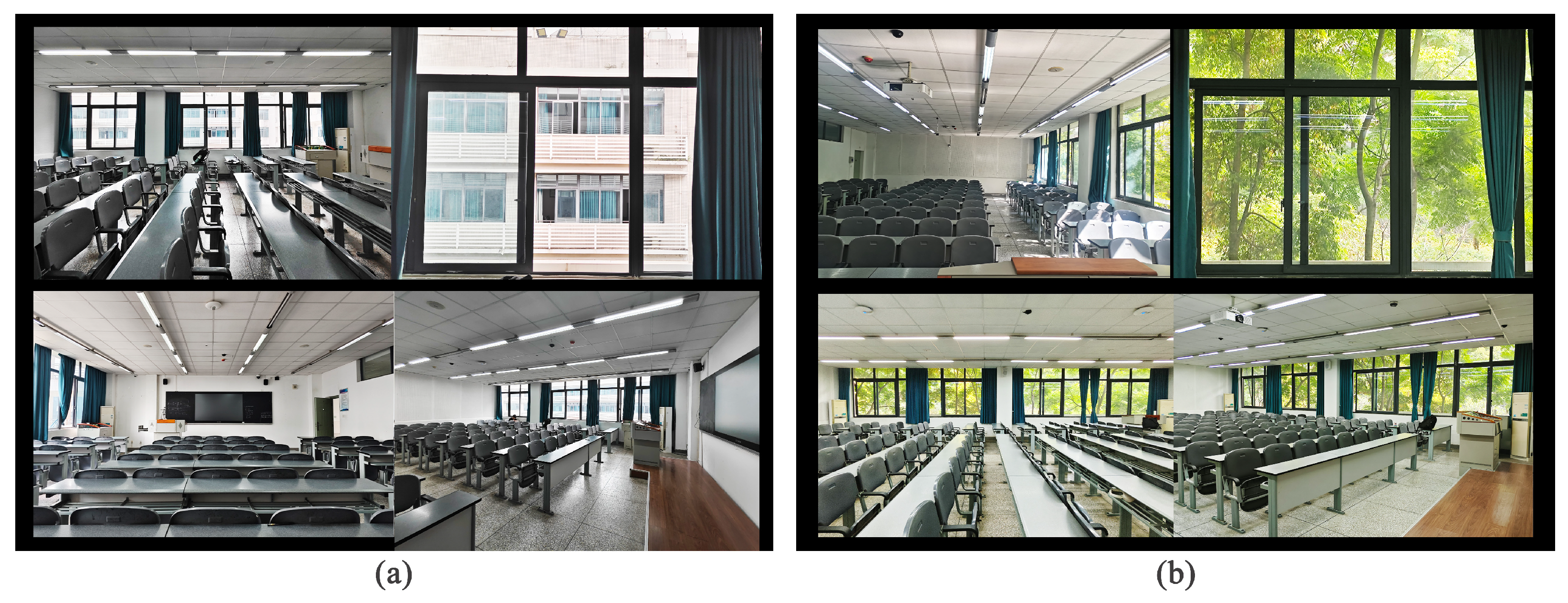

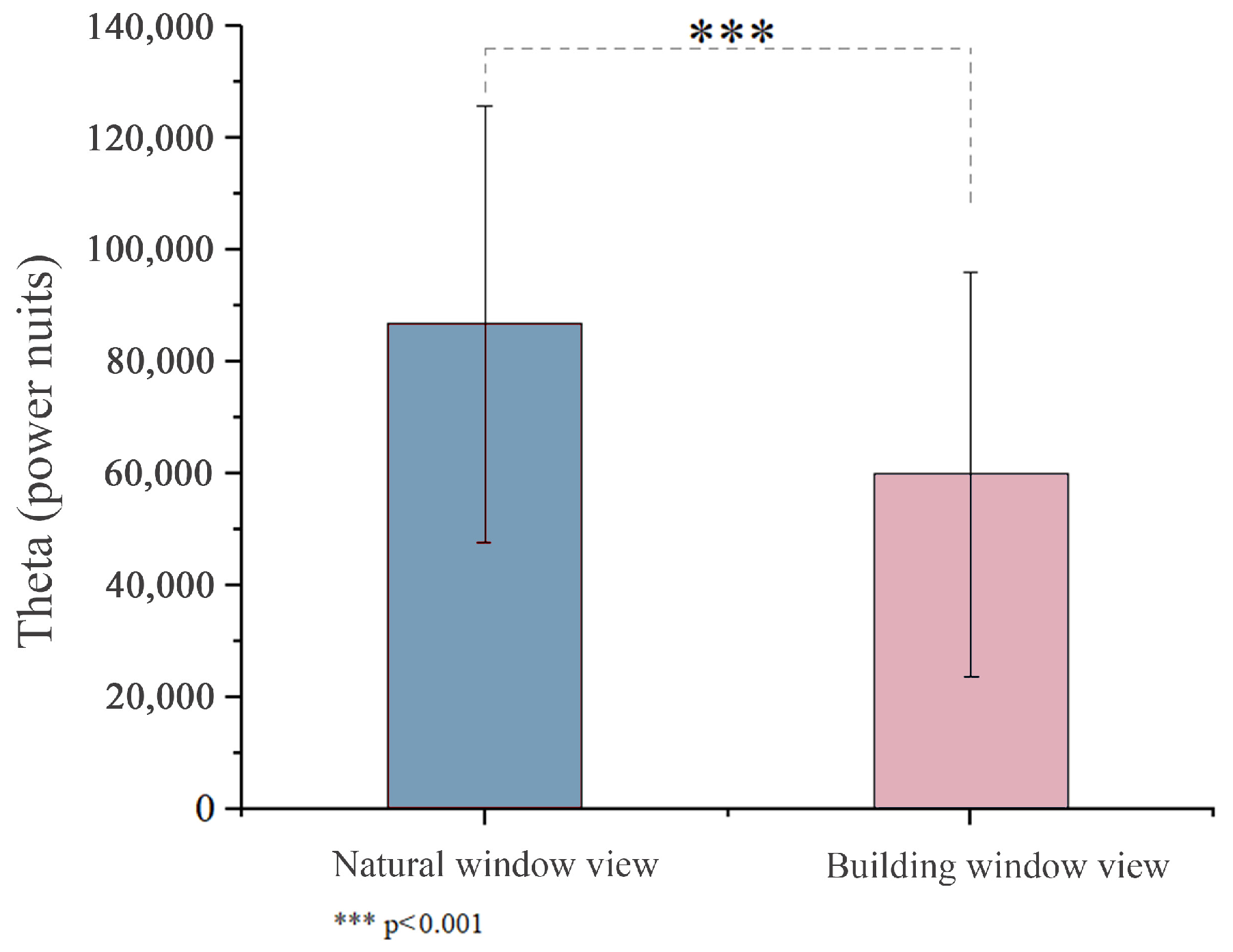
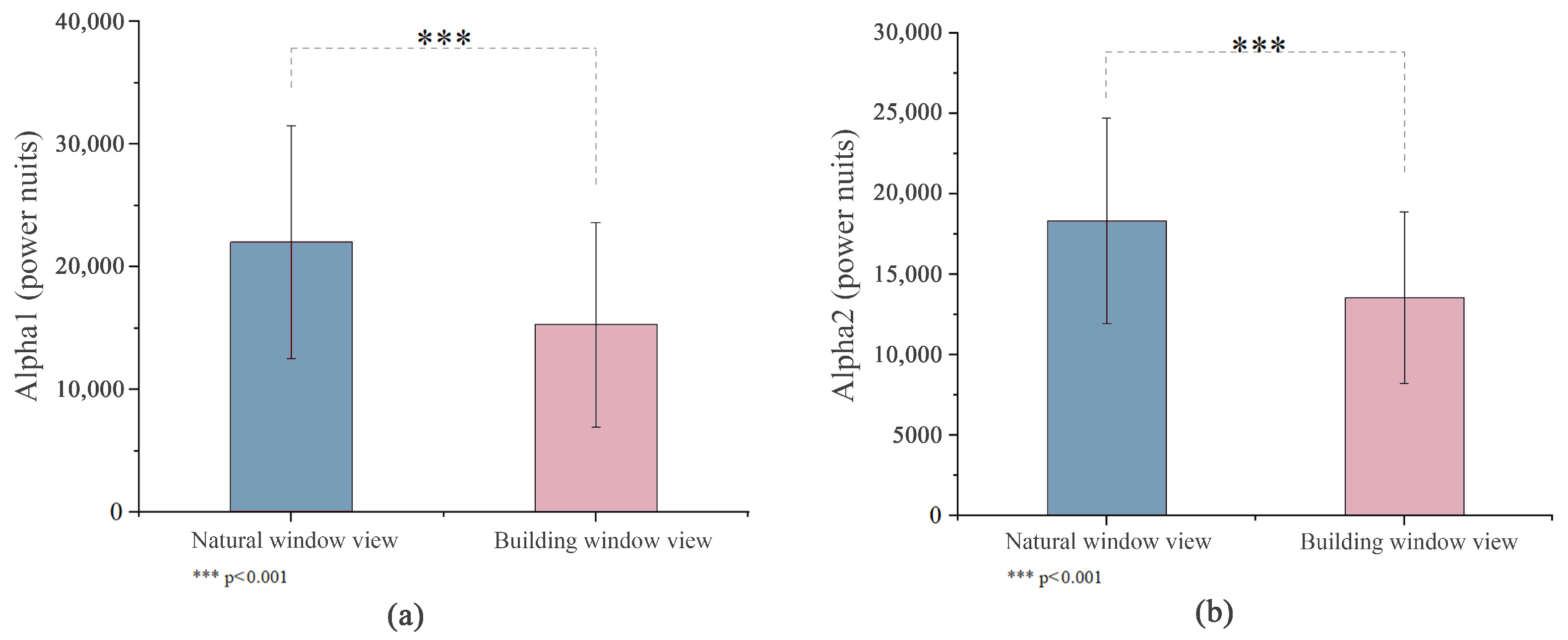
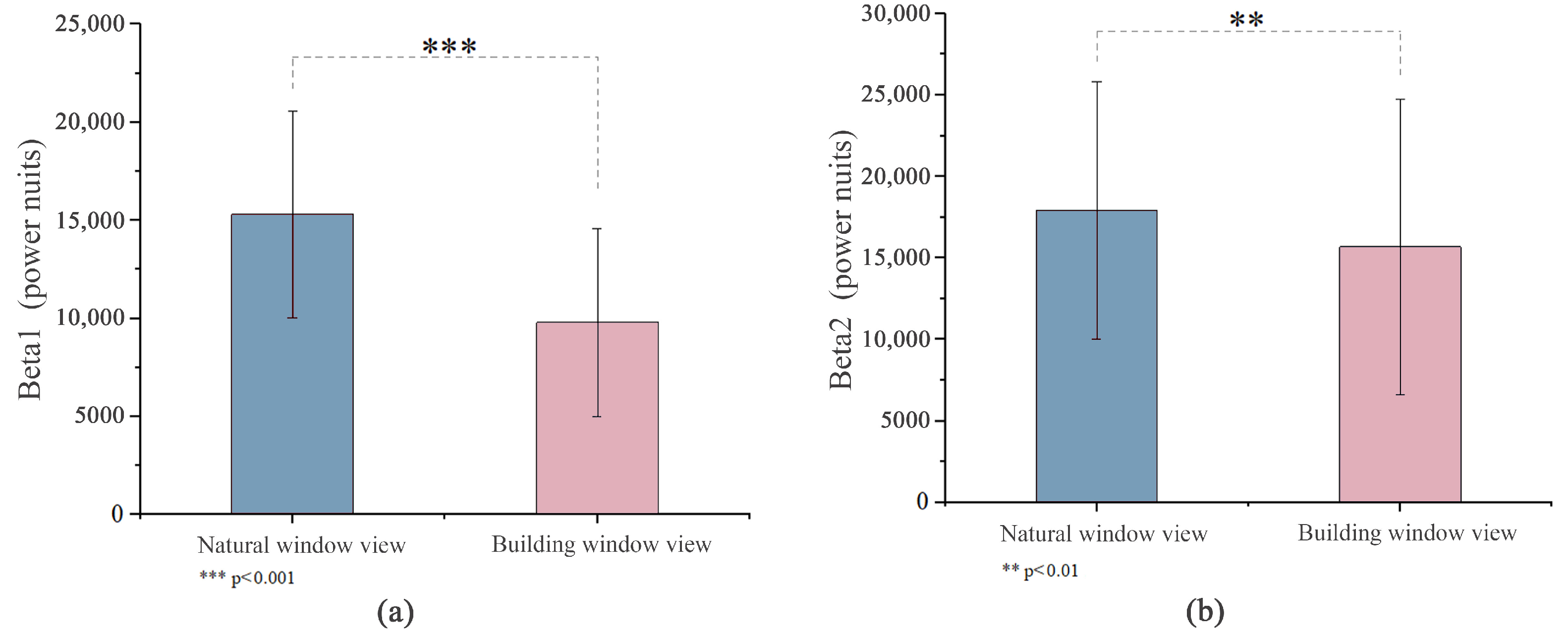
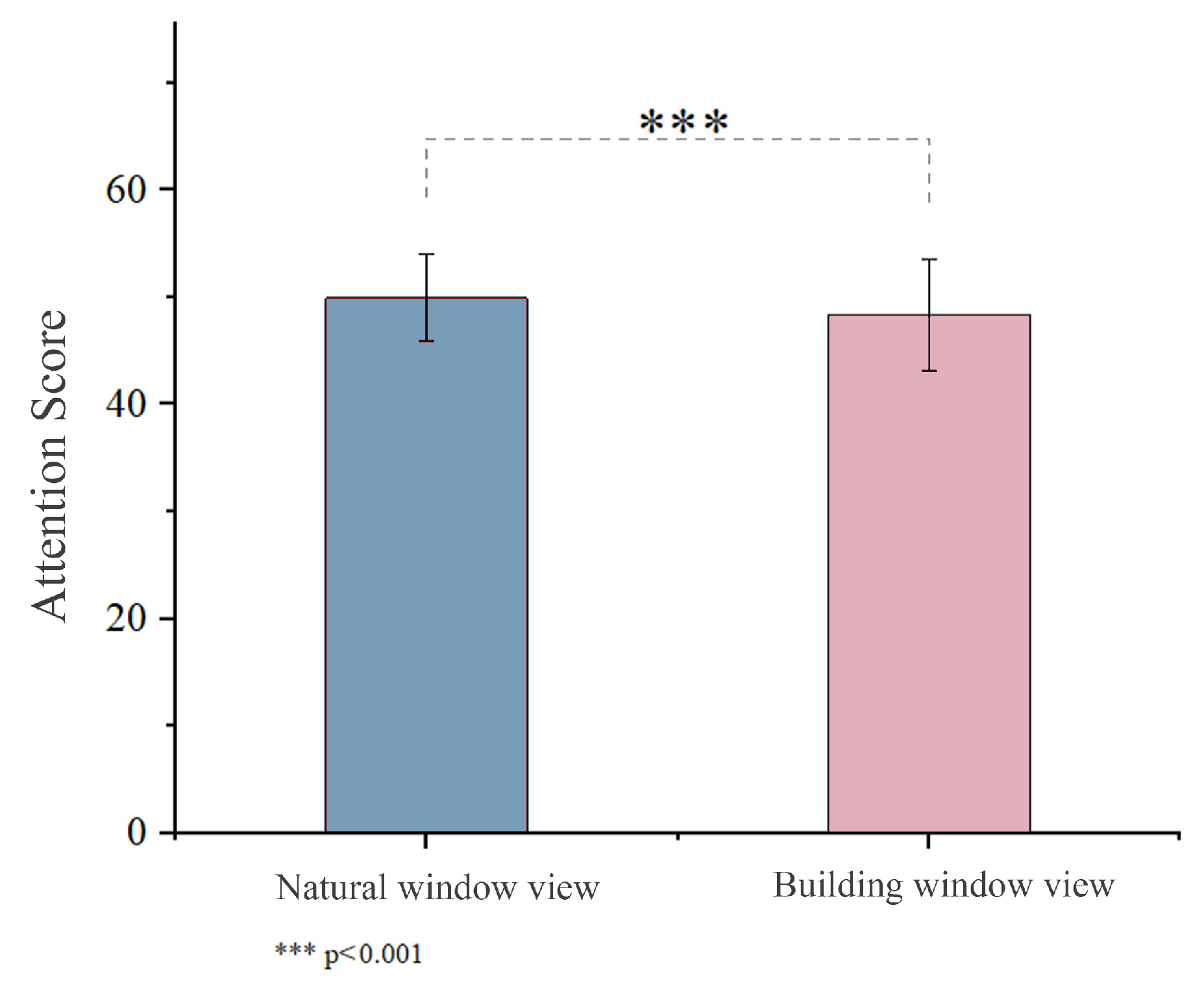

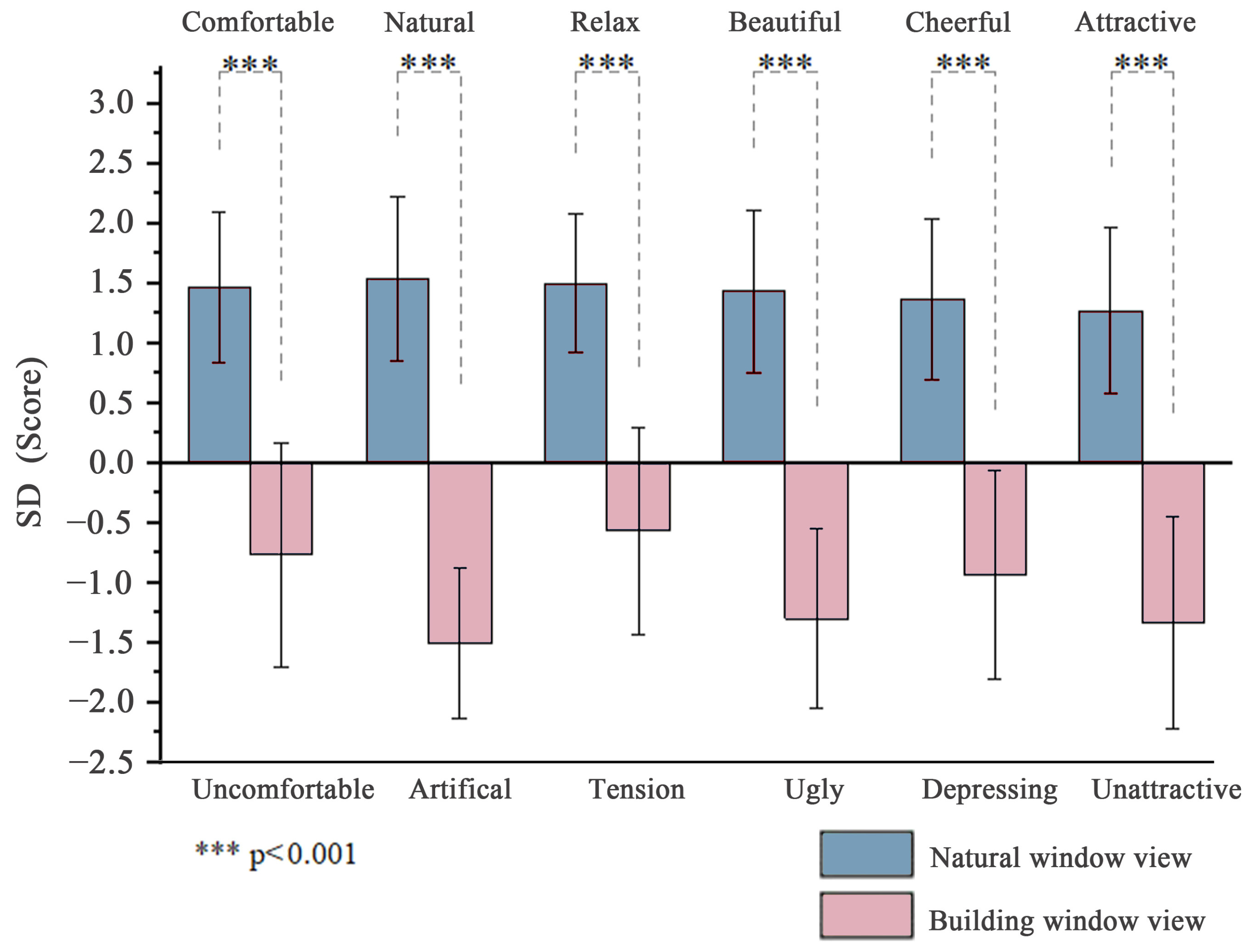

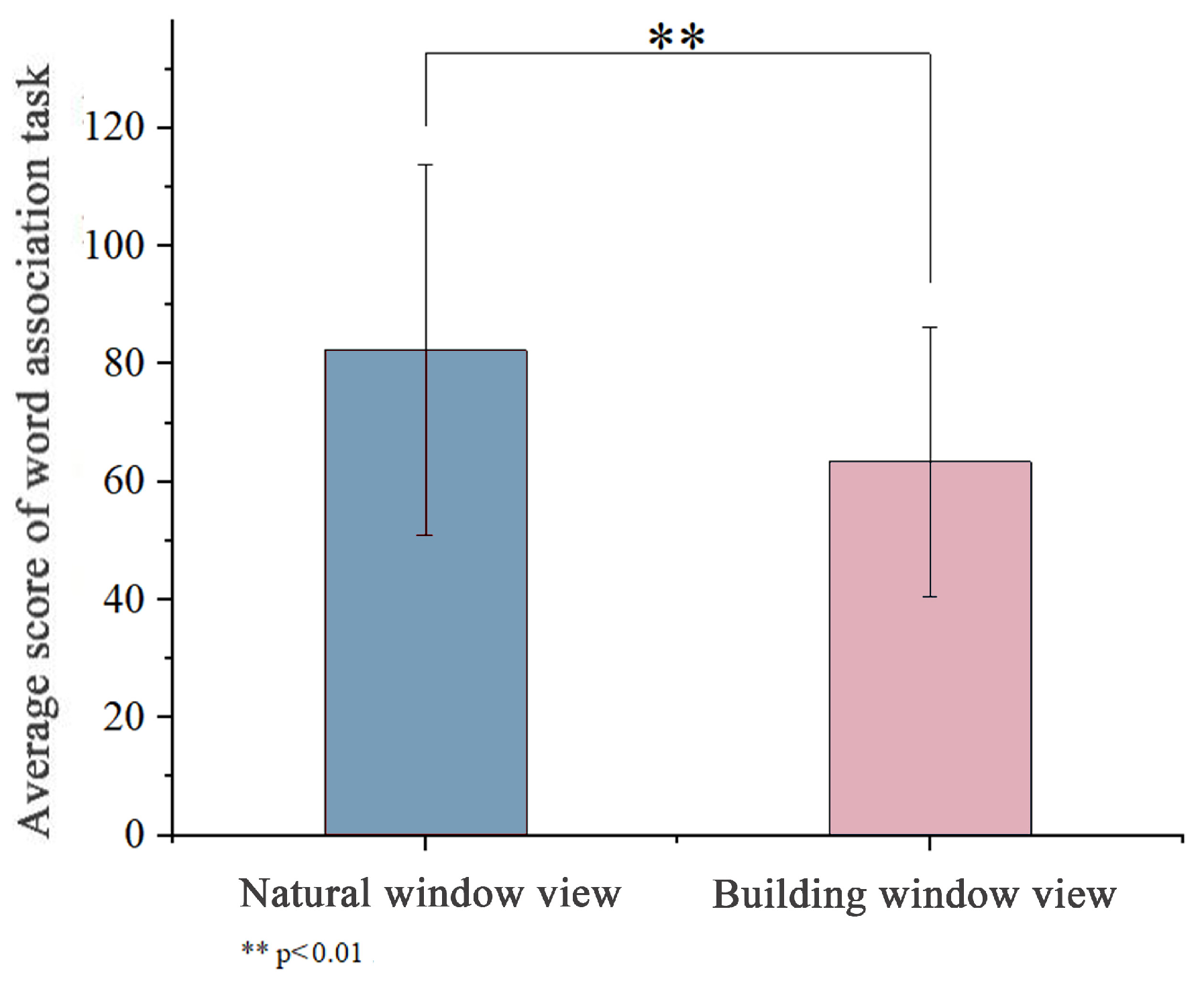
| Scales | Cronbach’s α |
|---|---|
| SD (Natural window view) | 0.91 |
| SD (Building window view) | 0.88 |
| POMS (Natural window view) | 0.77 |
| POMS (Building window view) | 0.90 |
Disclaimer/Publisher’s Note: The statements, opinions and data contained in all publications are solely those of the individual author(s) and contributor(s) and not of MDPI and/or the editor(s). MDPI and/or the editor(s) disclaim responsibility for any injury to people or property resulting from any ideas, methods, instructions or products referred to in the content. |
© 2024 by the authors. Licensee MDPI, Basel, Switzerland. This article is an open access article distributed under the terms and conditions of the Creative Commons Attribution (CC BY) license (https://creativecommons.org/licenses/by/4.0/).
Share and Cite
Zhang, Y.; Tang, Y.; Wang, X.; Tan, Y. The Effects of Natural Window Views in Classrooms on College Students’ Mood and Learning Efficiency. Buildings 2024, 14, 1557. https://doi.org/10.3390/buildings14061557
Zhang Y, Tang Y, Wang X, Tan Y. The Effects of Natural Window Views in Classrooms on College Students’ Mood and Learning Efficiency. Buildings. 2024; 14(6):1557. https://doi.org/10.3390/buildings14061557
Chicago/Turabian StyleZhang, Ya’ou, Yanhong Tang, Xiangquan Wang, and Yuanlong Tan. 2024. "The Effects of Natural Window Views in Classrooms on College Students’ Mood and Learning Efficiency" Buildings 14, no. 6: 1557. https://doi.org/10.3390/buildings14061557
APA StyleZhang, Y., Tang, Y., Wang, X., & Tan, Y. (2024). The Effects of Natural Window Views in Classrooms on College Students’ Mood and Learning Efficiency. Buildings, 14(6), 1557. https://doi.org/10.3390/buildings14061557





